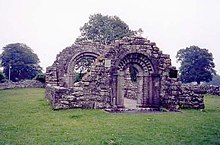Clonmacnoise
Clonmacnoise ( Irish : Cluain Mhic Nóise , "meadow of the sons of Nóise"; pronunciation : / kluəN´ v´ik´ noːs´ə /) is a unique ruined monastery in County Offaly , on the Shannon River in the Republic of Ireland . The history of the monastery goes back to the 6th century. Today the complex is one of the most visited tourist attractions on the Emerald Isle. The former monastery complex is only a few kilometers south of the town of Athlone, which is near the center of the island .
history
The founding of the Convent of the Iroschottische Church in 548 goes back to St. Ciarán . Four years later, Ciarán died at the age of 33, so that he no longer saw the monastery grow. The location was ideal: roads in all directions crossed here, and the Shannon as a waterway was an obvious asset. In the scriptorium a. a. the oldest surviving collective manuscript in the old Irish language, the Lebor na hUidre (German: Book of the dark-colored cow ), which contains a version of the Táin (German: cattle robbery by Cooley ), the central legend of the Ulster cycle.
From the 10th to the 17th century, new, small chapels and churches were built on the extensive site , which ultimately resulted in the entire complex. It is noticeable that none of the church ruins stand out particularly because of their size.
Clonmacnoise became a spiritual and intellectual as well as a craft center of Ireland. Many documents that are still known today point to the importance of the monastery. The workshops created particularly beautiful objects, especially bishop's staffs or reliquary containers . The complex had its greatest expansion in the 12th century.
But with that the decline began. The first to appear was the Vikings under Turgesius , then the Normans plundered and pillaged the monastery several times. Over 100 houses were cremated. It was also the Normans who built a castle in the immediate vicinity of the monastery, the remains of which are still enthroned on the small hill above the Shannon.
In 1552 English troops reached Athlone and tried to take possession of this monastery as well. The residents of the facility were able to defend themselves for over 100 years. Then Cromwell came and devastated this and hundreds of other monasteries. Since then, the facility has been left to decay. Clonmacnoise has been a national monument since 1877. In the mid-1950s, it was given to the state as a cultural heritage.
Attractions
- the Cathedral
- Nuns Church
- Temple Ciarán
- Temple Connor
- Temple Dowling
- Temple Finghan
- Temple Hurpan
- Temple Melaghlin
All that remains of the buildings are old, uncovered walls. The entire area is littered with grave slabs and crosses, all of which are several hundred years old. The Clonmacnoise high crosses have a special place in the history of Ireland. Today the three crosses are exhibited in a small museum in the entrance area of the facility. True-to-original copies are in their original places on the site.
Cross of the Scriptures
The inscriptions, which can hardly be deciphered today, suggest that this cross was consecrated to the Hochkönig Flann (877–915). The approximately four meter high cross is carved from sandstone and was probably built in the 10th century. The biblical depictions show the betrayal of Judas, the capture and the guarding of the tomb of Christ. But there are also very secular depictions such as the help of King Diarmuid in building a church or riders, chariots, hunters and animals.
North and South Cross
Only fragments of the north cross have survived. The shape of the Southcross is just as powerful as the Cross of the Scriptures. There are, however, significantly fewer pictorial representations carved in - and probably also not so clearly identifiable. Ornaments and geometric figures were used much more extensively for decoration.
Round towers
The ruins are dominated by a round tower . It dates from the 11th century and is around 17 to 18 meters high. Another round tower stands outside the monastery, on the banks of the Shannon.
Whispering Arch
The church in the center of the complex - also known as the cathedral - dates from the year 909 and houses a large number of graves and tombstones. An archway facing the Shannon is called a Whispering Arch. Allegedly you can hear the whispering on the opposite side of the church and priests of that time were able to confess to believers who had contagious diseases without risk. Whispering Arc is the groove that runs in the archway - if you whisper into this groove on one side of the gate, the sentence can be clearly understood on the other side of the archway.
See also
Web links
Coordinates: 53 ° 19 '35.4 " N , 7 ° 59' 9.6" W.





